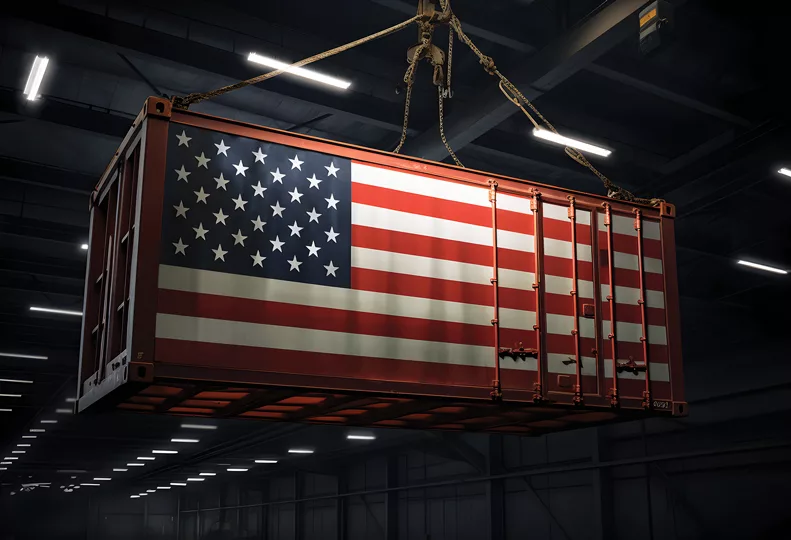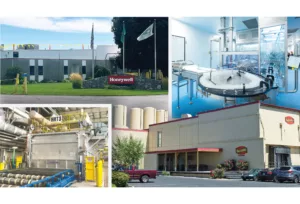
Trade headwinds hit the INW
Tariff policy creates immediate challenges for INW companies, even those who support the end goals

The Trump administration’s tariff policy, and the uncertainty and volatility that surrounds it, has had immediate and disruptive effects on some Inland Northwest businesses.
While many support the intentions and describe themselves as proponents of increasing manufacturing in the U.S., they raise concerns over the challenges that come with accomplishing such goals. Among its intentions, the tariff policy is intended to address the injustices of global trade, reshore manufacturing, and drive economic growth in the U.S., according to a statement on The White House's website.
Since the policy came into play, tariffs on a variety of countries have been announced, increased, decreased, canceled, and reinstated. The fluidity of the situation brings an additional layer of complexity for business owners who depend on international trade.
“That level of uncertainty is just adding so much frustration, cost, lead time. It’s put our industry in upheaval,” says Scott Tate, president of Tate Technology Inc., a Spokane Valley-based contract electronics manufacturer that produces complex circuit board assemblies.
Few of the components that Tate Technology buys are available in the U.S.
“We’re importing all of the raw components that we use to populate the circuit boards, and now everything has at least a 10% tariff on it,” Tate says. “And not only that, but if it comes from China, it’s 145% currently.”
Tate estimates that 20% to 30% of the materials Tate Technology is buying come directly from China. Most of those materials aren’t made elsewhere.
“I have no choice but to pay 145%,” Tate says.
The impacts reach further than the electronics and manufacturing industries, according to Grant Forsyth, the chief economist at Spokane-based Avista Corp.
In the Inland Northwest, one of the industries Forsyth worries most about is agriculture.
“So much of our agriculture that we produce in the state is exported, especially in Eastern Washington,” Forsyth says.
He says the risk for farmers is twofold.
The first risk is retaliation from other countries.
“What we saw in the first Trump administration is that when they imposed tariffs on China, China responded pretty strategically by imposing tariffs and other kinds of restrictions on U.S. agriculture, including what was being produced in Washington,” says Forsyth.
The other challenge is that farmers use a lot of supplies components that are produced outside of the U.S.
“They’re going to see probably some cost increase on the inputs they use to produce their agricultural output,” says Forsyth. “They’re going to potentially feel a double squeeze, in the sense that their revenues are going to be squeezed because of retaliatory effects, and they’re also going to face the cost squeeze because of input prices rising because of the tariffs.”
Those potential challenges aren’t exclusive to farming, however.
“It’s hard for me to think of an industry that isn’t going to essentially confront the same thing that the farmers are going to confront,” Forsyth says.
Forsyth says the tariffs have the potential to slow economic growth in the U.S.
“What you’re confronting is a decline on the revenue side, because of slower economic activity produced by the tariffs,” he says. “At the same time, you’re experiencing rising costs.”
Initially, it will be goods producers—those who are producing physical commodities—who will be at risk, in terms of both revenues and costs, Forsyth explains.
“But what happens is gradually, those costs get passed on via the market mechanism, and so sooner or later, service producers are also going to start to see higher costs, as goods producers are passing on those costs to everybody,” he says.
Spokane-based No-Li Brewhouse is among the businesses in the Inland Northwest that has already been impacted by the tariff policy.
John Bryant, No-Li’s owner, says it started with fuel costs.
“Immediately, our delivery surcharges have gone up for fuel, and that’s directly related to the scare of tariffs,” he says.
The cost of aluminum, much of which comes from Canada, has also risen. Malt barley, a lot of which is also produced in Canada, has also become more expensive due to the tariffs.
Despite the higher costs facing No-Li, Bryant says the company hasn't and won't raise its prices.
Instead, Bryant is finding other ways to deal with tariff-related challenges.
“We have been really active for months trying to renegotiate our contracts because we pay cash,” he says. “We’re in a position to negotiate better pricing because we are paying up front.”
He says No-Li is debt-free, which gives it some leverage.
Despite some success in renegotiating contracts, No-Li has experienced tighter profit margins because of tariff-related challenges, as well as other economic challenges, including inflation and high state taxes, Bryant says.
“We’re eating the margin,” he says.
For Tate Technology, the impacts of the tariffs were felt immediately.
“It happens so sudden, that a UPS truck will show up at our door, and they will not deliver their product unless we write them a check,” Tate says.
In one instance, Tate had ordered an item from a vendor in Taiwan when there were no tariffs in place yet. By the time that product arrived in the U.S., a 32% tariff rate had been placed on Taiwan.
“Somebody has to pay that tariff,” Tate says. “It’s not on the invoice from our vendor in Taiwan, therefore UPS has to pay it. Well, they’re going to charge me for it.”
When UPS arrived at Tate Technology, the delivery driver refused to give Tate the item until he paid the 32% difference, even though the tariff rate for Taiwan had dropped to 10% at that point.
That time, Tate ended up paying an additional $1,600 to UPS to cover the cost of the tariff and receive the item.
That type of situation has happened multiple times since, although more recently, the tariff rates are included in the invoices and paid upfront, Tate says.
Surprise delivery charges aside, the higher costs have continued for Tate Technology.
In February, Tate quoted a job with a per-unit cost of $20. When he requoted the job in April, the per-unit cost was $34.
He says that change is a direct result of the tariffs. Normally, in a two-month period, there might be an increase of 5%.
“We’re experiencing the price increase based on tariffs,” Tate says. “It’s an undeniable fact, and we don’t know what to do about it, because we don’t know what tomorrow is going to be.”
As a result of the higher costs, Tate says he has no choice but to pass those costs on to his customers, which consist of businesses in the industrial, military, aerospace, and medical sectors, among others.
Because of higher prices, Tate worries about demand decreasing—something he's already experiencing.
Tate Technology typically takes six to 12 weeks to complete an order.
“Which means if we look at our forecast, 12 weeks out should have stuff in it,” Tate says. “It’s empty.”
Although the company has cash reserves and is healthy enough to endure a catastrophe, Tate says he’s concerned about the lack of orders coming in.
He says, “If July is empty and August is empty, and the orders don’t keep coming in the door, what are you going to do?”
Tate says it’s completely plausible to predict a 30% to 50% reduction in orders, based on what he’s seeing.
“There’s still nothing, literally nothing, in July,” he says.
Challenges aside, Tate says he’s supportive of the intent of the tariff policy.
“I’m a manufacturer in the United States,” he says. “Of course, I’m a massive proponent on jobs for Americans and keeping things as local as we can. Of course, that’s what I want.”
He’s concerned, however, about how long it will take to reshore manufacturing, as well as the lack of a manufacturing workforce to support those efforts.
Tate asks, “If unemployment is at 4% to 5% and we don’t have enough community colleges, vocational schools to train a skilled workforce to operate equipment, if you opened up all the factories you needed to build all of this stuff just for the electronics industry, where are you going to find these people?”
Mark Norton, the executive director of the Northwest I-90 Manufacturing Alliance, echoes similar concerns about the workforce situation here.
“We’re already struggling with finding enough skilled trades and engineering talent, even just for the existing demand that we have,” Norton says.
Increased demand for workers will exacerbate the workforce shortage, he says.
“Wages are likely to be more competitive, and that could be another cost factor aside from sourcing material or products,” says Norton.
Norton is also concerned about how long it would take to set up manufacturing facilities.
“Building that infrastructure out is not going to happen in the next several months, or even a year,” Norton says, noting that he’s heard estimates that it would take five to 10 years to make a meaningful dent in rebuilding infrastructure here.
“In the short term, it’s going to mean (companies) are still going to be at the mercy of whatever the cost escalations are for offshore, because there’s just simply nowhere near enough supply for a lot of products and services domestically,” he says.
Despite the short-term impacts created by the tariff policy, Norton also supports the goal of reshoring manufacturing.
“I support the goal. I think that we need even more thoughtful strategy,” he says. “The administration maybe is underestimating the difficulty factor and the time factor.”



_web.webp?t=1764835652)
